Eduard Thum, 1847 - 1926
by Brian Stevenson
last updated November, 2018
One of the
most talented diatom-mounters of all time, Thum’s fine preparations are
generally in high demand by modern collectors. The majority of his diatom
preparations are of a single species, with several perfect frustules arranged
to permit studies of their structures. He also prepared “salon” slides of
diatoms, butterfly scales and other minute objects, arranged into stars or
other geometric patterns, or forming pictures of flowers, birds, etc. In
addition, Thum prepared skillful slides of thin-sectioned rocks, chemical
crystals, and other materials. He began his business around 1875, issued his
first catalog in 1879, and continued mounting until near the time of his death.

Figure 1.
An arrangement of diatoms, sponge spicules and
synapta plates and anchors, by Eduard Thum. He also made excellent, complex
arrangements of diatoms, butterfly scales and other tiny natural objects,
grouped in geometric designs or scenic patterns that look like flowers, birds,
etc. An American distributer, Mary Ann Booth, described those as Thum’s “Oh
My!” works. Thum acknowledged that such slides were prepared for admiration by
art lovers rather than scientific purposes. This image and examples of
arranged microscopic objects by other, contemporary mounters can be seen at http://www.victorianmicroscopeslides.com/slidegrp.htm.
Courtesy of Howard Lynk.

Figure 2.
The more common type of Thum diatom mounts contain a
small number of selected, arranged diatoms of a single species. Thum also
placed a large, circular diatom on either side of the specimen diatoms. These
are readily visible to the naked eye, and serve to guide the microscopist when
placing the slide on a microscope. On occasion, an additional diatom was placed
nearby – these serve no obvious function, and may have been included as a treat
for buyers. Illustrated are (clockwise from upper left): Cymbella cuspidatum,
Goniothecium odontlla, Surirella cornis and Pleurosigma secorum. The later,
English diatom-mounter William Gatrell frequently followed Thum’s pattern when
making his own slides.
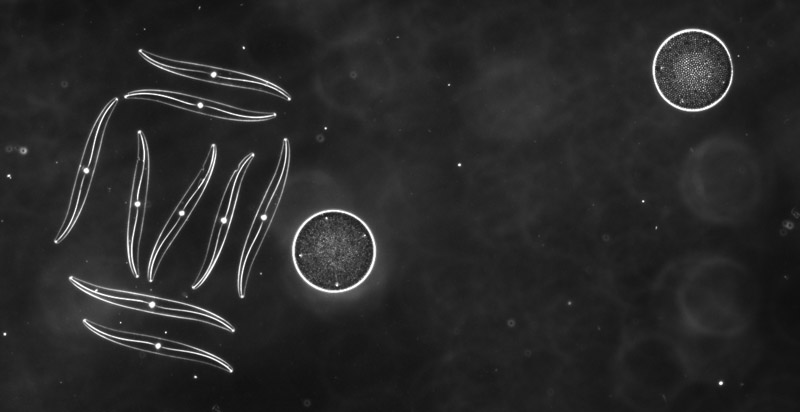
Figure 3.
A slide in which diatoms have drifted in the
mountant provides insight on Thum’s method. The specimen Pleurosigma strigilis
diatoms are still nicely arranged in a cluster, and the large, round, guide
diatoms are still appropriately spaced to flank the Pleurosigma. The most
reasonable explanation for this phenomenon is that the two diatom species were
set down in two different layers of different viscosities, allowing the diatoms
to drift at different rates.
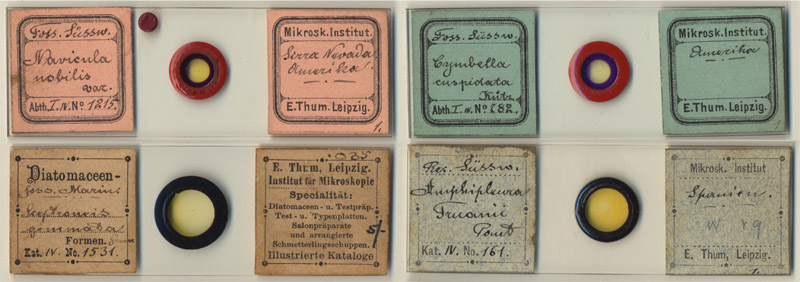
Figure 4.
Labels used by Thum on diatom slides. The pattern of
the upper two slides are the most common. The illustrated slides all contain
single species, arranged in patterns like those in Figure 2. Thum also prepared
slides with strews of impure diatoms. There are no known direct connections
between Thum and any other German microscopist who used similar labels or the
name “Mikroskopische Institut”.
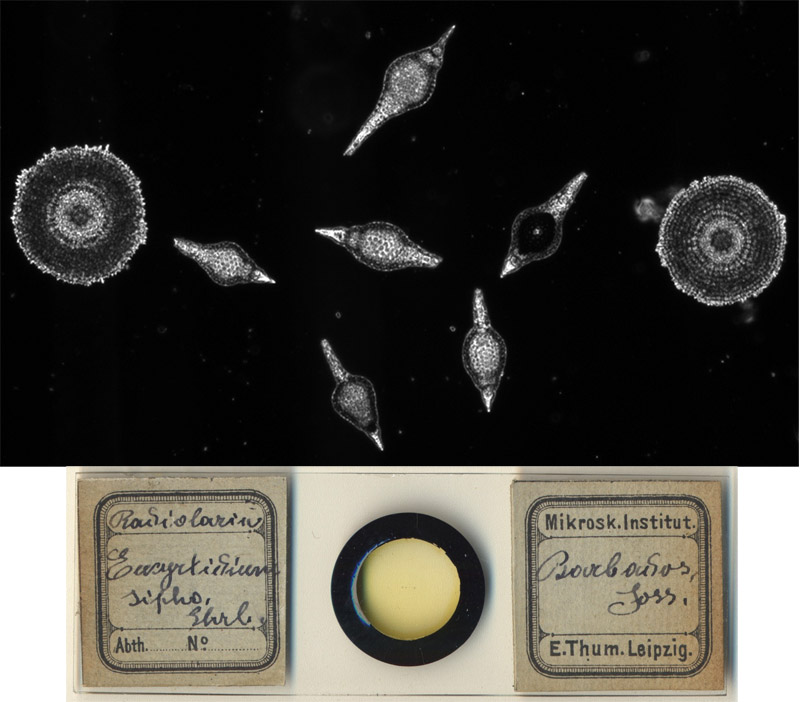
Figure 5.
Thum’s slides of other types of aquatic objects were
frequently arranged like his diatom preparations. Illustrated are fossil
Eucyrtidium sipho radiolarians from Barbados.

Figure 6.
As did virtually every other slide preparer of the
time, Eduard Thum mounted samples of ocean soundings from the celebrated
1872-76 explorations of the H.M.S. Challenger.
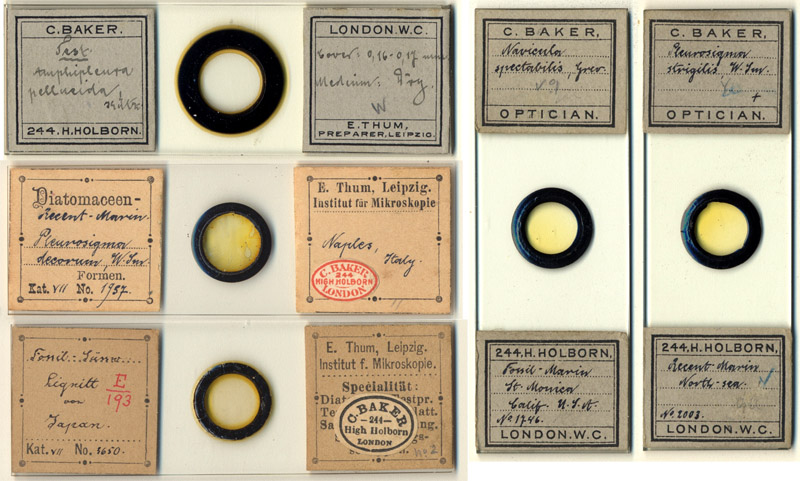
Figure 7.
C. Baker, of London, was Thum’s distributor in the
U.K. Thum is known to have prepared slides especially for Baker in the early
1900s, and customized Baker labels, or those with Thum’s handwriting, are
moderately common.

Figure 8.
Thum sold his business in 1916, to Franckh’sche Verlagshandlung of Stuttgart, who marketed his slides with association to their popular science magazine, "Mikrokosmos". Thum continued to work for Franckh’sche Verlagshandlung for several years afterward. The illustrated slides are a single-species preparation of Navicula nobilis and a mixed strew (“streu-präparat”).
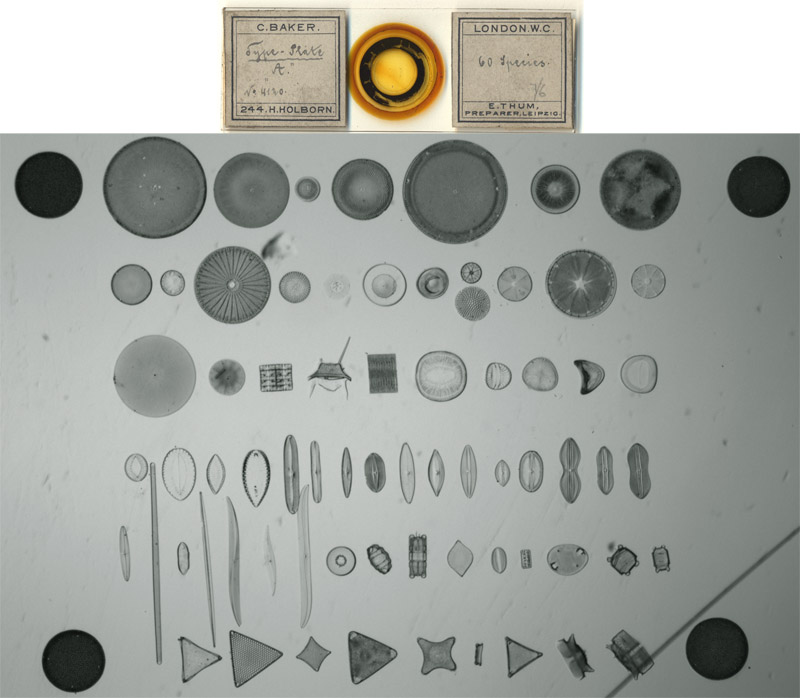
Figure 9.
A
60-diatom “typen-platte”, prepared specifically for sale by Baker in England. A
100-diatom typen-platte is illustrated at http://www.microscope-antiques.com/thumtypeslide.html.
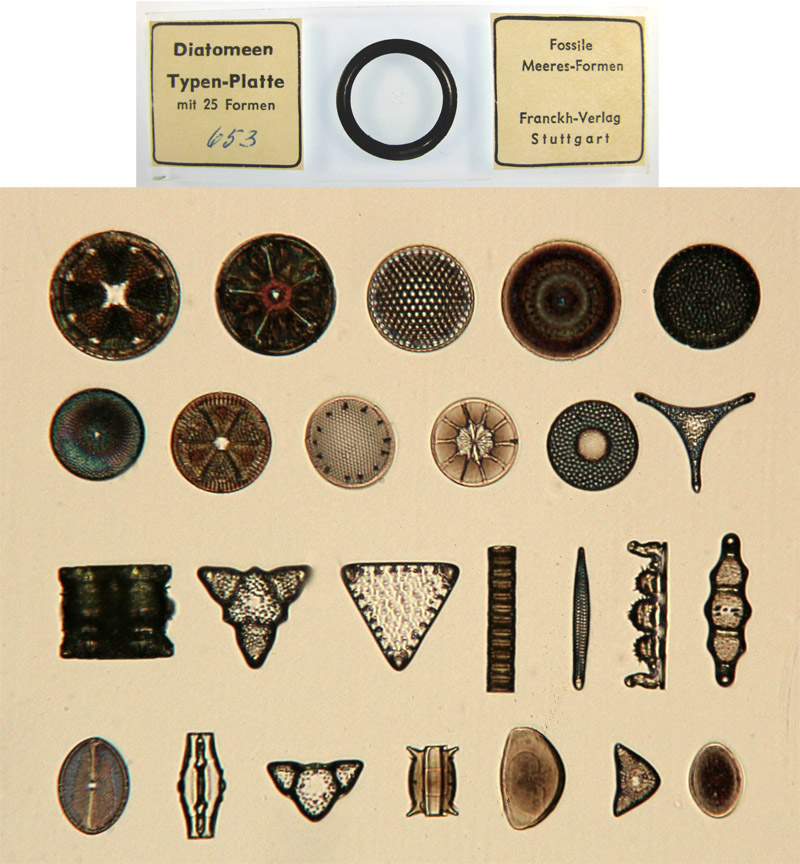
Figure 10.
A 25-diatom “typen-platte”, dating from after 1916, sold by Franckh’sche
Verlagshandlung.
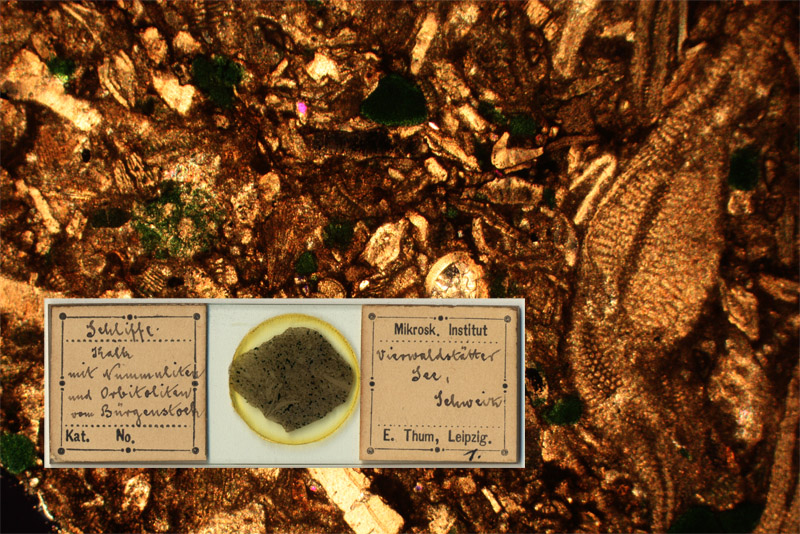
Figure 11.
Although chiefly known for his diatom mounts, Thum
produced excellent preparations of other objects. Illustrated is a thin-section
of chalk from Bürgenstock, Switzerland, showing nummulite and orbitolite
fossils. Photographed with crossed polarizing filters (polariscope).
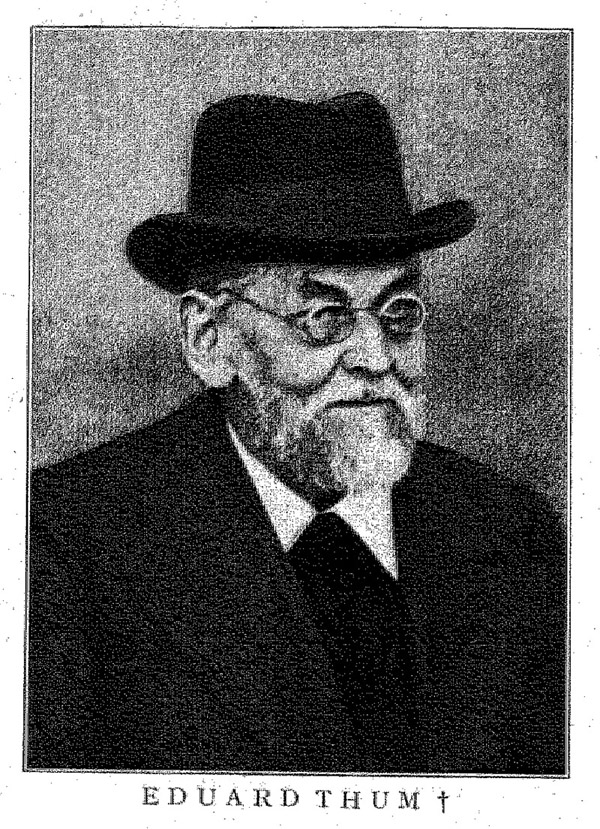
Figure 12.
Eduard Thum, circa 1926. From his obituary that appeared in Mikrokosmos.

Figure 13.
Excerpts from official address books of Leipzig. The
persistent referral to Thum as a “mechaniker” suggests that he may have
continued to work as a machinist long after he began producing microscope
slides. Slide-manufacturing may not have brought in enough income to be Thum’s
only occupation, especially in the early days before he developed a reputation
and multiple, regular customers.
Little is
known about Eduard Thum’s personal life. Thum’s obituary, written by colleague
Georg Stehli for his employer’s magazine, provided almost no information. From
that source, we know only that Thum was born in Leipzig, Saxony (Germany) on
April 7, 1847.
Some
insight can be obtained from address books of Leipzig (Figure 13). Microscopist
Eduard Thum first appears in these books in 1875, where he is listed as being a
“metalldreher” (metal turner/lathe
operator), living at 13 Emilienstrasse. The 1875 book also includes one Anna
Thum, described as “Kaufmanns Wwe.”
(merchant’s widow), living at 7 Burgerstrasse. The previous year’s address book
recorded that address as occupied by E. Eduard Thum, Burger and Kaufmann, who
operated a cigar and tobacco shop. The title “Burger” indicates that this Eduard Thum was an established,
respected citizen, an appellation not give to the microscopist until the
mid-1880s. Since microscopist Eduard Thum was a native of Leipzig, and
presumably an inhabitant of his home city when he was 27 years old in 1874, his
sudden appearance in the rolls right after the death of the tobacco merchant
with the same name suggests that our microscopist may have been the son of the
tobacconist, working for his father until the elder’s death left the son to
establish his own business. If that is true, then Anna Thum was the microscopist’s mother.
The 1866
address book lists the occupant of 7 Burgerstrasse as Friederick Wilhelm Thum,
a lottery agent. The fourth entry in the 1875 book is for a person with the
same name, also operating a lottery business (“Lotteriegeschaft”) (Figure 12). This suggests that the lottery
operator of 1875 was a close relative of our microscopist. The name “Thum” was very uncommon in Leipzig, so
it is possible that all such-named people were related to each other.
Stehli
wrote that Thum began his business when “Alter
von etwa 28 Jahren” (approximately 28 years old). That vague description
corresponds with the apparent independence of Eduard in 1875. The address books imply that Thum did not abandon his machinist work after he began his microscopy business. It is not known
whether he worked as a “metal turner”
for an employer or operated an independent business. However, that skill
suggests that some or all of the microscopy equipment that Thum sold were made
by himself. Among these were “algensucher” (algae viewer) microscopes (Figures
14 and 15). These simple microscopes are pocket-sized (approximately 1 ½ inches
/ 4 cm tall), have almost no moving parts, and are very ruggedly built. Thum
sold these to diatom hunters and other naturalists for field use. One could
easily place a small sample of collected material between two slides, clamp
them into the algensucher, and quickly determine if the sample contains
anything of interest. Many of the algensucher microscope sets I have seen
include a slide that has a shallow indentation, perfect for holding a fluid
sample.
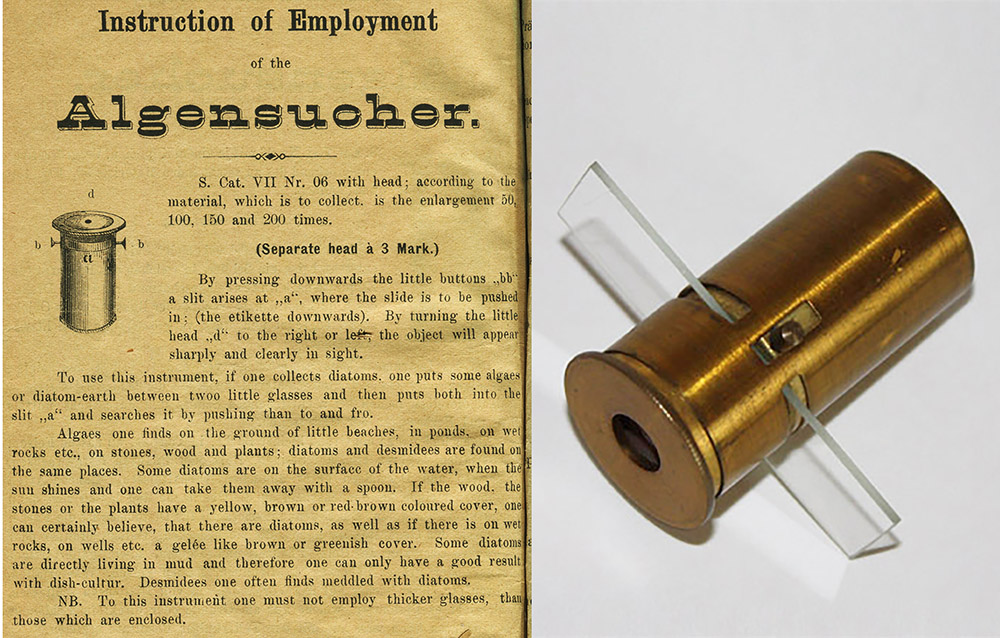
Figure 14.
Eduard Thum sold "algensucher" ("diatom finder") microscopes/magnifiers throughout his career. He was a skilled metal turner, and so probably produced his own algensuchers and other microscopy tools. At left is a description of the algensucher and directions for its use, from Thum's 1895 catalogue. At right is an example of an algensucher, from another maker.
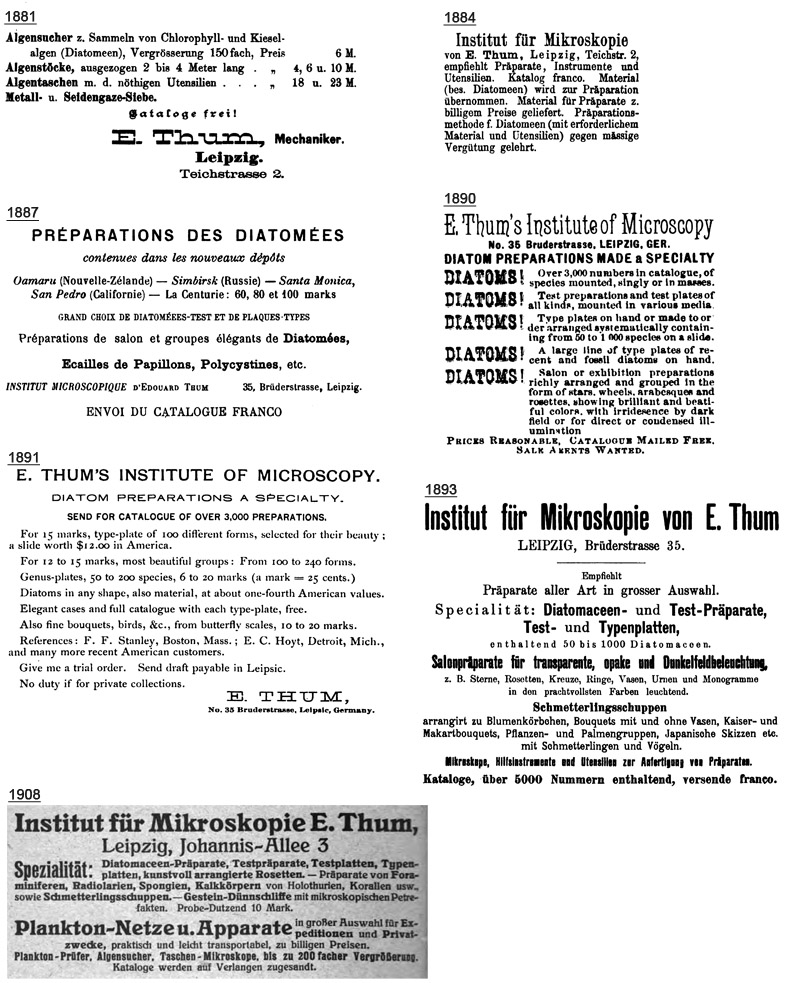
Figure 15.
Advertisements issued by Eduard Thum, and appearing in German, French, English and U.S. magazines. Notice that he sold (and probably made) simple microscopes and sample-collecting equipment.
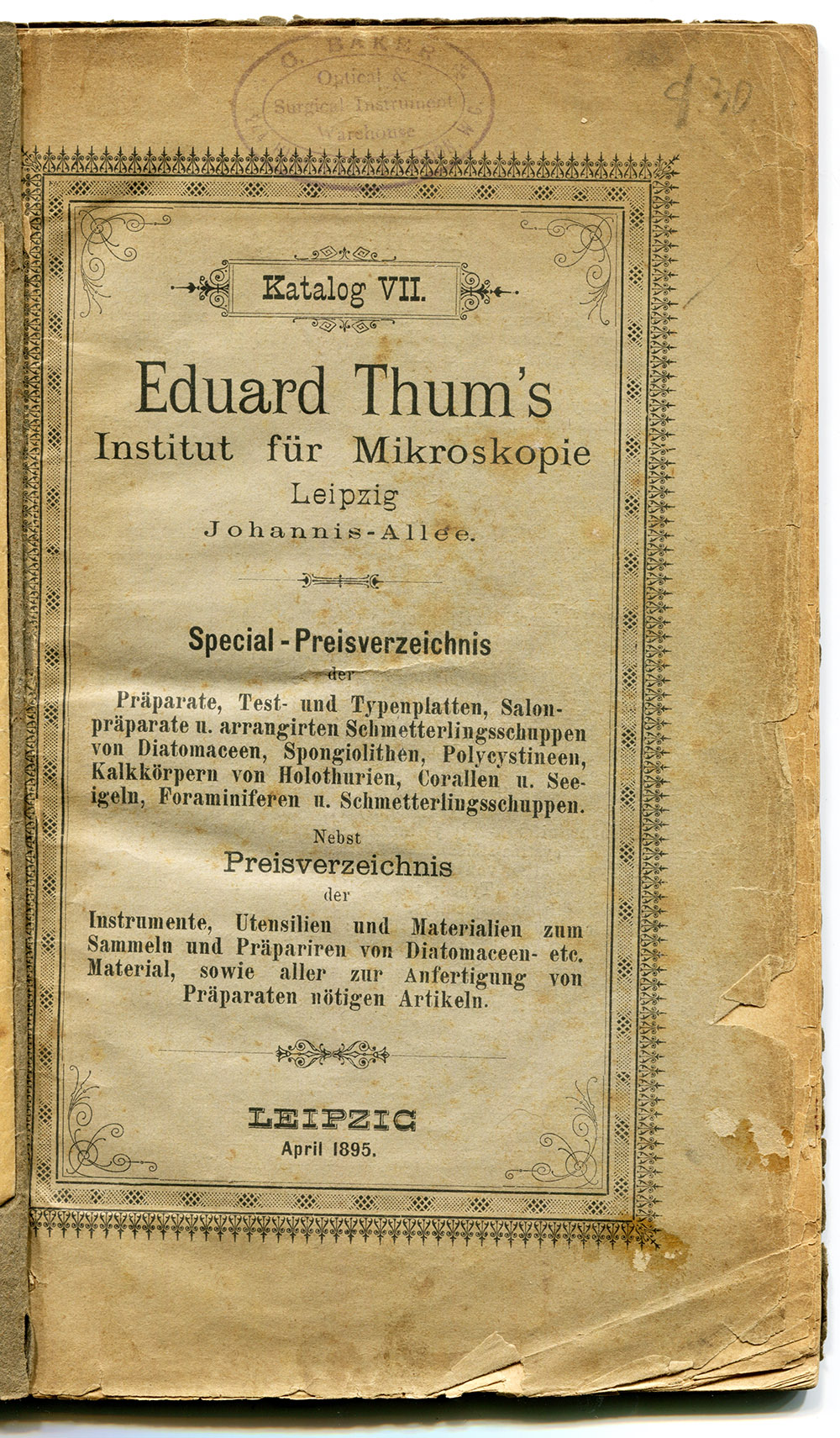
Figure 15B.
Cover of Eduard Thum's 1895 catalogue.
As did several other German slide-makers of the era, Thum styled his business “Institut für Mikroskopie” or “Mikroskopische Institut” (Institute for Microscopy or Microscopic Institute). There were no known business connections between Thum or any other German slide-maker who operated under such names.
Karlheinz Rosenbauer’s Mikroskopische Präparate reports that Eduard Thum issued his first microscopy catalog in 1877. He
offered microscopes, related equipment, and microscopic specimen preparations.
His slides were available in either large or small formats (standard 1x3 inch
“English” or 5/8 x 2 1/4 inch “Continental” sizes).
Between 1878 and 1879, Thum moved to 2 Teichstrasse. His earliest identified advertisements list this address (Figure 15).
Thum was evidently very devoted to collecting and studying diatoms. In 1880, he
published two lengthy articles in Isis
on “Die herstellung von Diatomeen
präparaten” (the production of diatom preparations) and “Ueber das sammeln und präpariren der Diatomeen” (on the collection
and preparation of diatoms). Frederick Mills and Julien Deby, in their An introduction to the study of the
Diatomaceae, cited a third 1880 paper by Thum, “Ueber das sammeln von Diatomeen auf salzigem gebiete” (on
collecting diatoms in salty areas), which appeared in das Natur.
Thum moved to 35 Bruderstrasse between 1885 and 1886.
Rosenbauer
notes that Thum’s fourth catalog, issued in 1889, contained 44 pages. He offered
2050 types of diatoms in 3469 different preparations. Numerous “salon”
preparations of arranged diatoms, butterfly scales, etc. were advertised.
As can be
seen from sample advertisements shown in Figure 14, Thum’s preparations were
available in several countries beyond his native Germany. He engaged retailers
abroad to manage that distribution. In 1889, Charles Riedy of San Francisco
announced, “Having been appointed sole
Pacific Coast agent for the general Microscopical Laboratory of Mr. Arthur C.
Cole, London, and also for the Marine Biological
Laboratory of Mr. J. Sinel, Jersey, the matchless productions of these renowned
preparers will always be kept in stock. I am also sole agent on this Coast for
E. Thum, Leipzig, whose slides of arranged diatoms
and opaque mounts of butterfly's scales and diatoms, are absolutely unequaled
for exquisite beauty and unique design. Microscopists who may be visiting San
Francisco, as well as those residing here, are cordially invited to call and
avail themselves of the opportunities offered them for the inspection of these
beautiful objects, under suitable conditions of amplification and illumination”.
In 1891, the editor of the US journal The
Microscope announced, “Miss M.A. Booth, Longmeadow, Mass., has taken the agency for Thum's arranged objects.
These are magnificent things, and the low price is in no way comparable with
their excellence”. Booth also commented, “the price of my well-known slides will be the uniform one of 50c. each,
$5.00 per dozen. Send 2c. stamp for catalogue and 50c. for slide of Podura
scales, test, or other diatoms, or of miscellaneous objects. Thum's ‘Oh, My!’
slides of arranged diatoms, gorgeous butterfly scales, etc., at lowest rates”.
Edmund
Spitta, in his 1889 Photo-micrography,
wrote, “We know of no mounter of diatoms
in the United Kingdom that can surpass Mr. Firth, of Clifton Park Avenue,
Belfast, and few that can equal him, save Mr. Gatrell, of Barnes, whose work is
of the most excellent quality; but Thum, of Leipzig, and Moller, of Wedel Holstein,
also supply slides of exceptional merit and perfection. We think they can be
obtained at Messrs. Watson & Sons, and at Baker's, both addresses being in
Holborn”.
At the May (1891) meeting of the San Francisco Microscopical Society Mr. Runyon exhibited
a slide prepared by Thum, of Leipzig, and presented
by the San Francisco College of Pharmacy to A. H. Breckenfield, in recognition
of his valuable course of lectures on 'Microscopy’ before the class of last
year. This slide contained 1,230 diatoms, arranged in the form of a monogram.
It was stated that 112 hours of patient labor had been expended in its
preparation”.
Around
1896, Thum moved again, to 3 Johannis-Allee. That year’s Naturalists’ Directory noted that Thum’s catalog included 5000 objects.
Brian
Bracegirdle’s Microscopical Mounts and
Mounters noted that a 1901 catalog from London’s C. Baker states that they
were negotiating with Thum to supply them with slides. Slides with Baker’s
generic labels and Thum’s handwriting, and others with Thum’s name prominently
displayed on Baker labels are still fairly common (Figures 7, 9 and 16). Thum’s
handwriting on such labels indicates that Baker must have sent labels to their
suppliers, which were then attached and filled out at the place of production. The
chemical crystal slides illustrated in Figure 16 indicate that Thum provided
more than just diatom preparations to Baker.
Thum sold
his business to the publishing house of Franckh’sche Verlagshandlung in 1916
(the date of 1906 given in Microscopical
Mounts and Mounters is apparently a typographical error, Thum’s obituary
states that he sold his business ten years before his death, while Mikroskopische Präparate states a 1916
sale date and provides several examples of Thum advertising under his own name up
until 1916). Thum continued to work for that company, who sold the slides under
the brand Mikrokosmos (Figure 8).
As a final
note, since Eduard Thum’s microscope slides were prepared in Germany and
exported to France, the UK and the USA (at least), it is striking that the
majority of his slides that are offered for sale nowadays come from the UK.
Perhaps there are troves of Thum’s works in attics and basements around the
world, waiting to be rediscovered?
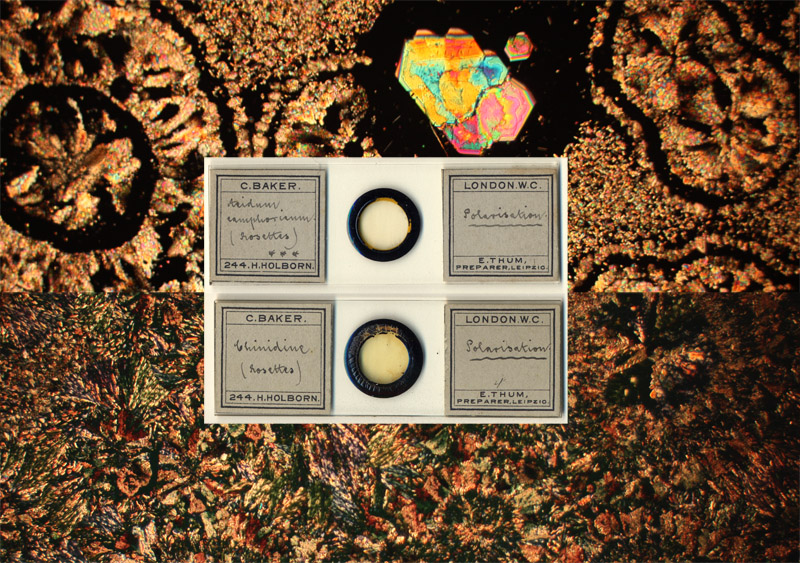
Figure 16.
Chemical crystal slides prepared by Eduard Thum and
sold by Baker. Photographed through crossed polarizing filters.
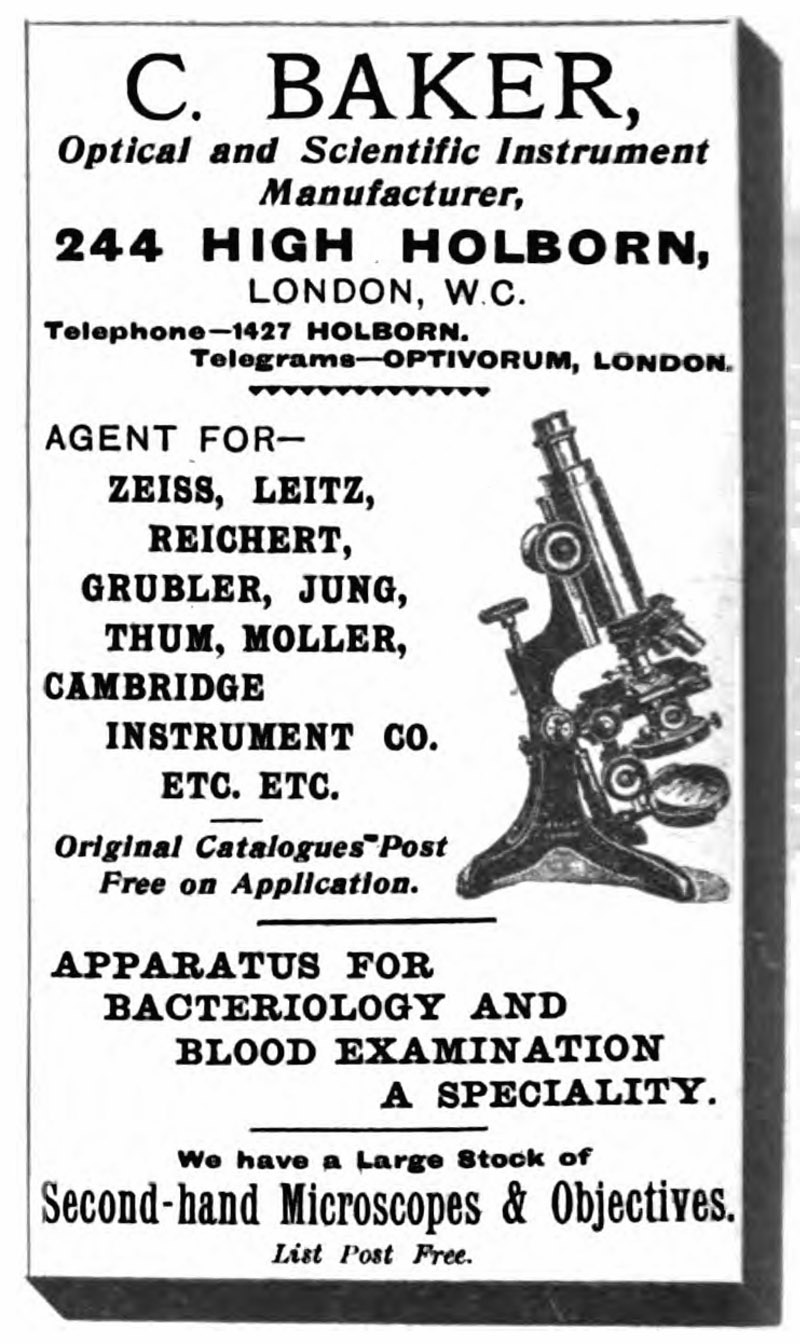
Figure 17.
A 1905 advertisement from Baker.
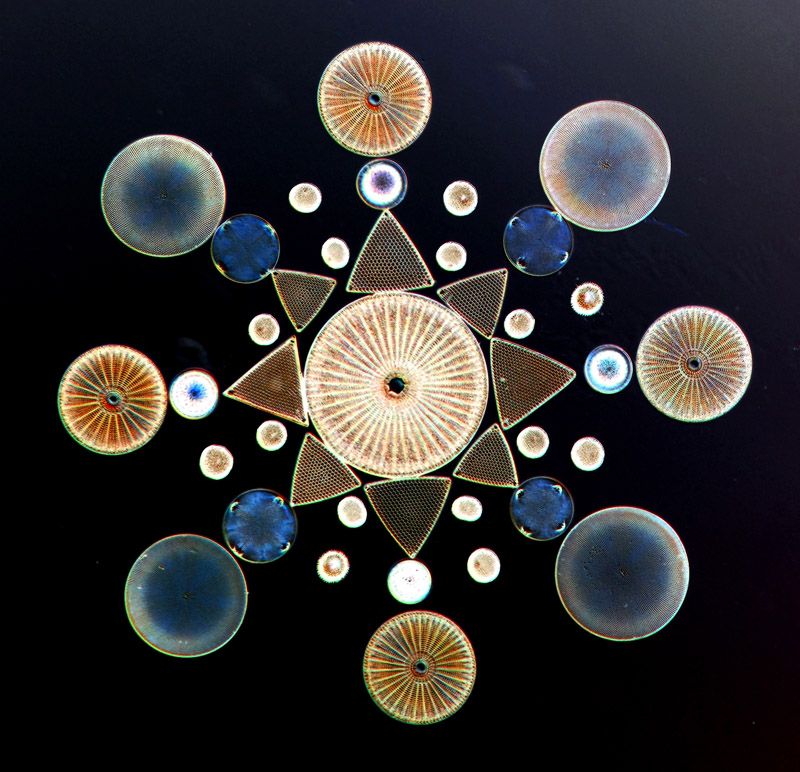
Figure 18.
Another salon-preparation by Thum. This image and examples of arranged microscopic objects by other, contemporary mounters can be seen at http://www.victorianmicroscopeslides.com/slideexb.htm.
Courtesy of Howard Lynk
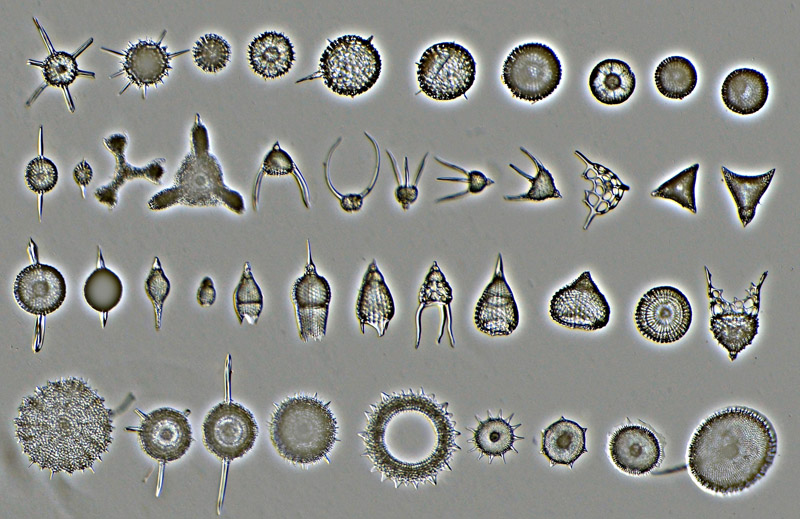
Figure 19.
A Thum typen-platte of radiolaria. Courtesy of Howard Lynk
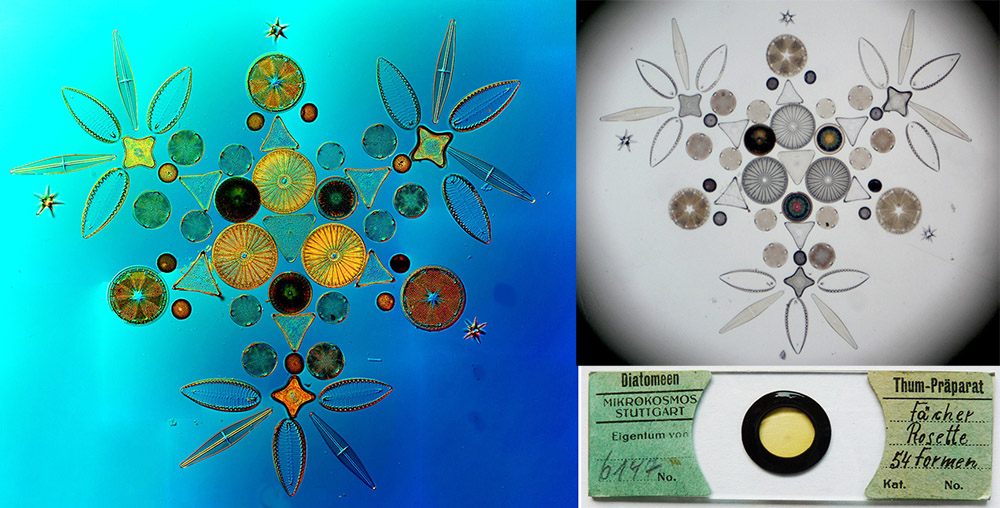
Figure 20.
A salon arrangement of diatoms by Thum, retailed by Franckh’sche
Verlagshandlung, after 1916. Adapted for nonprofit, eductional purposes from an internet auction site.
Acknowledgement
My thanks
to Howard Lynk for helpful discussions and for the images shown in Figures 1,
18 and 19.
Resources
Address books of Leipzig, accessed through familysearch.org,
wiki-de.genealogy.net, and ancestry.uk.co
American Monthly Microscopical Journal (1891) Advertisement from Eduard Thum, Vol. 12, page vi
American Monthly Microscopical Journal (1891) An elegant slide, Vol. 12, page 166
American Monthly Microscopical Journal (1891) To microscopists, Vol. 12, page 168
Antique Microscopes, Antique Microscope Slides, and other
Antique Scientific Instruments (accessed March, 2014) 100 form typen-platte, http://www.microscope-antiques.com/thumtypeslide.html
Baumgarten,
P. (1893) Advertisement from Eduard Thum, in Jahresbericht
über die Fortschritte in der Lehre von den Pathogenen Mikroorganismen, H.
Brun, Braunschweig, advertising section in back of book
Botanisches Zentralblatt (1881)
Advertisement from Eduard Thum, Vol. 5, page 70
Bracegirdle, Brian (1998) Microscopical Mounts and Mounters, Quekett Microscopical Club,
London, pages 8, 94, 174, 192, and 216 , and plates 35 C-F, 44-R-S, and 56-D
A Cabinet of Curiosities (accessed March, 2014) Images of
Eduard Thum’s salon preparations of arranged diatoms: http://www.victorianmicroscopeslides.com/slidegrp.htm
and http://www.victorianmicroscopeslides.com/slideexb.htm
Davis, George E. (1889) Advertisement from Charles C. Reidy,
Practical Microscopy, New and Revised Edition, W.H. Allen, London, between pages 8 and 9
Internationale
Revue der Gesamten Hydrobiologie und Hydrographie (1908) Advertisement from Eduard Thum, Volume 1, Issue 6, back page
Journal de Micrographie (1887)
Advertisement from Eduard Thum, Vol. 11, page 416
Journal of the Royal
Microscopical Society (1908) Advertisement from C. Baker, Advertising
sections
The Microscope (1890)
Advertisement from Eduard Thum, Vol. 10, advertising section
The Microscope (1891)
Vol. 11, page 86
Mills, Frederick W. and Julien Deby (1893) Citation of “Thum E. - Ueber das Sammeln von Diatomeen auf
Salzigem Gebiete, Natur n 43, N. F. p. 537. Halle 1880”, An introduction to the study of the
Diatomaceae, Iliffe and Son, London, page 225
The Naturalists’ Directory (1896) “Thum, E., Institut für Mik., Leipzig, Katalog mit
5000 Kuinmern. Kauf. u. Tausch von Materiatien. Johannis-Allee 3. Diatomaccen, Polycystineen, Spongioliten,
Forminiferen”, page 72
Rosenbauer, Karlheinz A. (2003) Mikroskopische Präparate, Vol. 1, John Wiley & Sons, pages 101-103
Spitta, Edmund J. (1889) Photo-micrography,
Scientific Press, London, page 130
Stehli,
Georg (1927) Eduard Thum, Mikrokosmos,
Vol. 20, page 104
Thum, Eduard (1880) Die herstellung von Diatomeen präparaten, Isis, Vol. 5, page 104
Thum, Eduard (1880) Ueber das sammeln und präpariren der Diatomeen,
Isis, Vol. 5, pages 319-320
Zeitschrift für Wissenschaftliche Mikroskopie and
Mikroskopische Technik (1884) Advertisement from Eduard Thum, Vol. 1,
advertising section




















